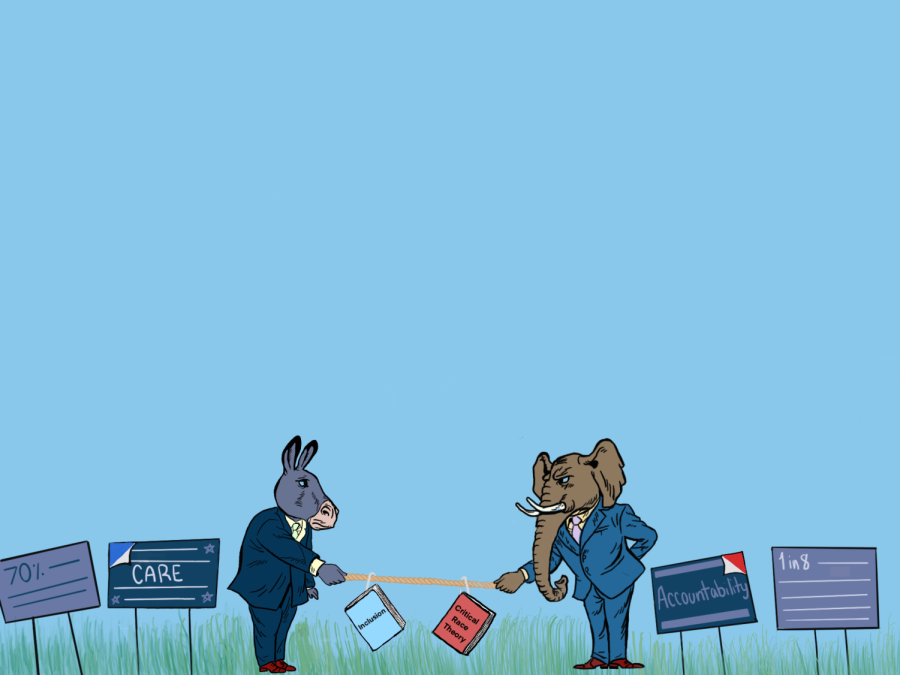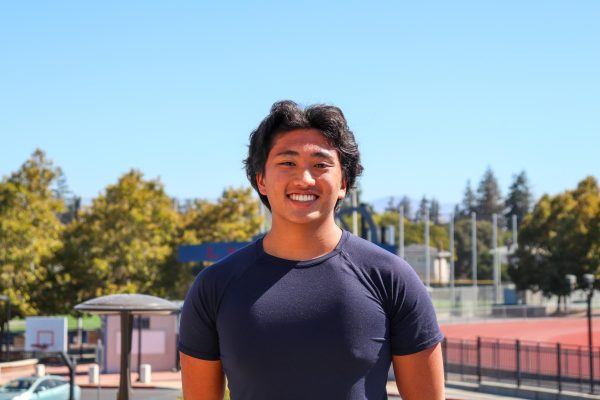Partisan politics’ latest casualty: School Boards
Graphic Illustration by Apurva Krishnamurthy and Inaaya Yousuf
A donkey and elephant, representative of the two major political parties duke it out in a game of tug of war over local school board campaign signs. Graphic Illustration by Apurva Krishnamurthy and Inaaya Yousuf.
November 7, 2022
School boards are meant to be nonpartisan and voice the community’s opinions to improve their schools. Yet in practice, they have transformed into ideological battlegrounds. From banning Critical Race Theory to restricting books that contain “offensive language,” both Democrats and Republicans have shown negligence through weaponizing public education to further partisan interests over student’s needs. Thus, school board members should pledge non-partisan stances on their duties. Community members should strive to hold members accountable to minimize the unrelenting advance that many policy makers have taken towards our public education system.
As inherently democratic institutions, school boards are responsible for allocating funding for various programs, approving curriculums and overseeing the distribution of school resources. Discipline and safety in particular sparked discourse between Democrat and Republican voters as students returned to in person learning in the fall of 2021.
Partisan politics have been leaking into public education for decades, from debates ranging from how to prevent school shootings to the divestment of public schools in favor of private and charter schools. However, such policies have caught the public eye during the transition back to in-person learning during the pandemic. Tensions boiled in communities as some failed to agree on public safety measures during the COVID-19 pandemic. Republicans saw some of these safety measures as an affront to limit their personal freedoms, using the slogans “My Body My Choice” as a satirical spin on the traditional left-leaning slogan pertaining to abortion. Democrats viewed Republican attacks as increasingly inflammatory, stressing the importance of safety.
“I think what galvanized elections in the last five years is fear of change or that something doesn’t match a cultural value,” social studies teacher Jeffrey Bale said.
As discourse about pandemic-era health and safety policies started to subside early last year, Critical Race Theory took center stage. Bans on books and curriculum that address topics pertaining to marginalized groups have since expanded, especially in predominantly conservative areas. These bans politicize what should be an objective education, while unnecessarily sugarcoating sensitive topics, ranging from slavery and the Civil War in American history to contemporary issues surrounding racism, class and inclusion. Proponents of parent oversight claim that students are being indoctrinated in school solely by educating them on topics unpalatable only to conservative minds.
“School boards have become such ideological battlegrounds because people are concerned about their children’s education,” said Roy Rocklin, FUHSD board of trustees member. “By focusing on children’s education, you can get parents’ attention. It’s a political wedge issue.”
Although federal or state policy affecting public education is inevitable, the changes that they bring are often less tangible in comparison to local initiatives, including district-level governments. As such, school boards have a significant effect on students’ education.
With such critical decisions being made, the importance of communication between board members and citizens becomes even greater. Most school board meetings have time restrictions, around 2-3 minutes, for public comments. They also require community members to notify the board of what and when they plan to discuss in advance, disrupting the flow of productive dialogue and limiting community input. Moreover, most school boards don’t sufficiently advertise their policies or provide meeting minutes, often leaving voters in the dark.
To combat the possibility of an uninformed or unsatisfied electorate, school boards can loosen these regulations or implement open-door meetings. Such meetings allow citizens to address their concerns and remain informed on specific matters by conversing with board members one-on-one, fostering a community of educated voters. This will also minimize polarization by encouraging voters to vote based on policy rather than defaulting to party affiliation.
School boards can only do so much to be transparent and communicative as possible. Community members must also take initiative to voice their concerns and vote for candidates that they believe will actually prioritize their students’ best interests.
“The problem is people failing to understand that their votes are important and that they have a civic responsibility to vote,” Bale said.
Most areas are not a voting monolith, and in the liberal stronghold of California, where left leaning ideas and officials dominate politics, Republicans may feel underrepresented or disenfranchised during school board elections. Due to this disparity, candidates frequently run nonpartisan campaigns to prevent voter apathy and encourage majority and minority opinions. However, this phenomenon begs the question of what it means to be truly nonpartisan.
“There are a lot of people that are either one party or the other, and there is no middle ground,” FUHSD student board representative Rochelle Awuah said. “It’s become very extreme overtime.”
School boards stimulating polarized environments and harboring partisan policies have put the quality of students’ education at risk. Moving forward, proper communication and responsible voting will be instrumental in transitioning away from political polarization. Prioritizing education over partisan pursuits will in turn, help to put student interest back at the top of school boards’ list.





























































